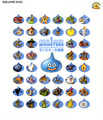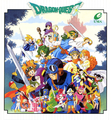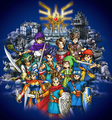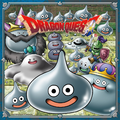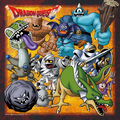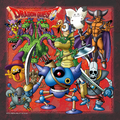Dragon Quest (series)
Dragon Quest (ドラゴンクエスト Doragon Kuesto) is a series of role-playing games made by Yuji Horii, Akira Toriyama, Kōichi Sugiyama and Square Enix (originally Enix) for a variety of video game platforms. 30 years after its debut, it is the all-time best-selling video game series in Japan, and enjoys increasing worldwide popularity through a stronger international marketing push with the merger of Enix and Square.
Each game in the main series of games is titled with the name Dragon Quest followed by a roman numeral. Since 1986, which marked the release of the original Dragon Quest, Dragon Quest has so far featured eleven games within the main series, as well as several spin off games. It has also featured several animated productions.
Dragon Quest is often compared with the Final Fantasy series, created by SquareSoft. Although the Dragon Quest series started before Final Fantasy, it continues to release titles at a slower paces within the main series (11 versus 16 total games). The two competed for more or less the same market until the companies' merger in 2003, at which point Dragon Quest became the main financial pillar of the company amidst wavering popularity and unreliable sales of the Final Fantasy series.
Installments of the series have appeared on MSX computers, Famicom/NES, Super Famicom/Super NES, Game Boy Color, Game Boy Advance, Nintendo DS, PlayStation, PlayStation 2 and Wii video game consoles, as well as on several models of mobile phone. As of May 2021, the Dragon Quest series has sold over 82 million units worldwide.[1] It is Square Enix's second most successful franchise after Final Fantasy and is one of the most popular video game franchises in Japan.
Common Themes[edit]
Every Dragon Quest game is told primarily through the eyes of a Hero named by the player, usually a prophesied "Chosen One" or a similar concept that requires him to rise against a new evil. Often, this evil is a Dragonlord or some kind of demon, but one that invariably wishes to take over the world and enslave or destroy humanity. Unlike other games in the genre, which have since the turn of the century begun to take on more of a science fiction bent, Dragon Quest tends to lean more towards traditional fantasy, with medieval technology and trappings. With certain exceptions, most games take place in a world distinct from every other; there is next to no direct continuity between installments, with each game taking place in a world envisioned from the ground up ad hoc.
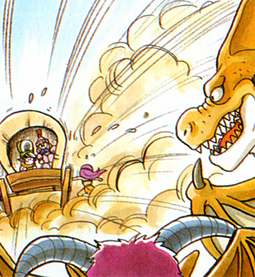
However, Dragon Quest I-III and IV-VI can be considered related through their storytelling. II is a direct sequel to the original game, while III is a prequel that effectively makes a trilogy; IV, V and VI each feature the Zenithia castle as an important plot element, and so fans have come to call them the "Zenithia trilogy." However, Yuji Horii has stated that this second group was never intended to be related.
Magic is frequently an important element, as both an in-battle ability of player-controlled characters and the cause of various world-shaking events.
As a pioneer in the RPG realm, Dragon Quest games have a reputation for being "bread and butter" representatives of the genre. The player advances through the game by carrying out pre-determined actions directly related to the progression of the plot, such as collecting a key item or defeating a particular antagonist. Usually, one of his first orders of business is to gather a party of like-minded warriors to join him on his quest. As the party traverses the landscape and various dungeons, they will be forced to fight (or, if they choose, flee from) enemies based on a "random encounter" system. Later in the game, the party often acquires improved transportation that may allow them to avoid such skirmishes. Battles are turn-based; the player delivers combat instructions each turn from an in-battle menu system. Some games feature AI that sees all party members but the Hero character responding to situations based on various factors at hand, sometimes including general orders such as "Attack ferociously" or "Go all-out with magic."
Defeating enemy characters yields "Experience Points" (EXP). When a certain number of EXP has been accumulated, the character levels up and becomes stronger, improving in a number of areas represented by statistical values that affect their performance on the battlefield. This system means that if a player finds any part of a Dragon Quest game too difficult, he can simply fight against weaker enemies until he becomes strong enough to have an easier time of it.
Design[edit]
The Dragon Quest series is primarily the work of three men: Yuji Horii is the scenario writer and lead designer; Akira Toriyama is the character designer, bringing in a style reminiscent of his manga works; and Kōichi Sugiyama handles the music production.
Development[edit]
History[edit]
In 1982, Enix sponsored a national video game programming contest, which brought much of the Dragon Quest team together, including Yuji Horii. The prize of the competition was a trip to the United States, and a visit to AppleFest '83 in San Francisco, where Horii discovered Wizardry. Kōichi Nakamura and Yukinobu Chida, two other winners of the contest, along with Horii, released The Portopia Serial Murder Case for the Famicom for Enix. Sugiyama, already famous for jingles and pop songs, impressed with the group's work, sent a postcard to Enix, commenting on the software. In response, Enix asked him to write music for some of its games. The group then decided to make a console role-playing game, using a combination of Wizardry and Ultima. Dragon Ball creator Akira Toriyama, who knew Horii through the manga magazine Shonen Jump, was commissioned to illustrate the characters and monsters to separate the game from other RPGs of the time and the Dragon Quest "team" was born.
Dragon Quest was created by Yuji Horii, who has been the scenario director since. The series monster and character designs, as well as box art, are done by famed Dragon Ball manga artist, Akira Toriyama. All of the music for the Dragon Quest series has been composed by Kōichi Sugiyama. Dragon Quest games have been developed by Chunsoft, Heartbeat, ArtePiazza, and, starting with Dragon Quest VIII, Level-5. Horii's own company, Armor Project, is in charge of the Dragon Quest games, which were published by Enix and, since April 2003 by Square Enix. While Toriyama is the series' character designer, the primary designs are first conceived by Horii, before being handed to Toriyama to re-draw under Horii's supervision. When Horii first created Dragon Quest, most people doubted that a fantasy series with swords and dungeons instead of science fiction would become popular in Japan; but the series has become a phenomenon there.
Dragon Quest is not nearly as successful outside Japan, having been eclipsed primarily by Final Fantasy and possibly by other RPG series. Because of Enix America Corporation's closure in the mid 1990's, the SFC versions of Dragon Quest V: Hand of the Heavenly Bride and Dragon Quest VI: Realms of Revelation were never officially released in North America. In Europe, none of the games have seen release prior to the spin-off Dragon Warrior Monsters and then Dragon Quest VIII: Journey of the Cursed King. With the merger of Square and Enix in 2003, the number of places in which Dragon Quest games are released has greatly increased. In May 2008, Square Enix announced localizations of the Nintendo DS remakes of Dragon Quest IV, V and VI, collectively called by Square Enix the Zenithia trilogy, for North America and the PAL region. With this announcement, all the main games in the Dragon Quest series will now have seen release outside Japan at least once.
The ninth installment, Dragon Quest IX: Sentinels of the Starry Skies, was released in Japan for Nintendo DS in July 11, 2009. In North American it was released a year later in July 11, 2010 and a few days later in Europe on July 23 while Australia and New Zealand got the game the following month on August 10.
The tenth installment of the main series, Dragon Quest X, is a massively multiplayer online role-playing game (MMORPG) and it was released on August 2, 2012 only in Japan for the Wii, Wii U (2013), Microsoft Windows (2013), Android (2013), iOS (2013), Nintendo 3DS (2014), PlayStation 4 (2017) and Nintendo Switch (2017).
The eleventh installment of the series is Dragon Quest XI: Echoes of an Elusive Age, it was released in Japan on July 29, 2017 for the Nintendo 3DS and the PlayStation 4. During the release in Japan it was announced that an international version was going to be released in 2018, the date was later confirmed to be September 4, 2018 for North America and Europe.
Creation and Design[edit]
"At the time I first made Dragon Quest, role-playing games on the computer were still very much in the realm of hardcore fans and not very accessible to other players. So I decided to create a system that was easy to understand and emotionally involving, and then placed my story within that framework." —Yuji Horii
Yuji Horii originally used the full-screen map of Ultima and the battle and stats oriented Wizardry screen to create the gameplay of Dragon Quest. The first six Dragon Quest games' stories are divided into two trilogies. The first three games of the series tell the story of the legendary hero known as Roto (also known as Erdrick or Loto in the American NES and GBC versions, respectively). Dragon Quest IV, V and VI are based around a castle in the sky called Zenithia, and are referred to as The Tenku in Japan, meaning Heaven. The main series from Dragon Quest VII: Fragments of the Forgotten Past on are independent of each other and stand alone.
The typical Dragon Quest plot involves a certain villain to be defeated at the end of the game, usually one who threatens the world in some way. However, the plotline often consists of smaller stories involving different NPC's the player meets as the adventure goes on.[16] The games themselves feature a number of religious overtones—saving the game (in later games) and reviving characters who have died is performed by clergy in churches. Priests are often seen wandering around the overworld of Dragon Quest Monsters and have the ability to heal. The final enemy in some of the Dragon Quest games is known as the Demon Lord. For instance, in Dragon Quest VII, the Demon Lord, known as Orgodemir in that particular game, is the final boss, and there is also a sidequest to battle The Almighty himself. The first four Dragon Warrior titles suffered from substantial censorship in their North American localizations, largely in keeping with Nintendo of America's content guidelines at the time, which placed severe restrictions on religious iconography and mature content. When these games were remade for the Game Boy Color, many of these censorships were taken out. Since Dragon Warrior VII, the games have been kept similar to their original versions when going through localization.
Name change[edit]
Dragon Quest's North American name was changed due to a trademark conflict with the role-playing game DragonQuest, which was published by veteran wargame publisher SPI in the 1980s until the company's bankruptcy in 1982 and purchase by TSR, which then published it as an alternate line to Dungeons & Dragons until 1987. In 2003, Square Enix registered the Dragon Quest trademark in the United States, and has since not marketed any product under the Dragon Warrior name since the North America 2005 release of Dragon Quest VIII: Journey of the Cursed King.
Games[edit]
Main Series[edit]
| Title (followed by original title) |
Platforms of release | ||
|---|---|---|---|
| In Japan | In North America | In the PAL region | |
| Dragon Quest Dragon Quest |
Famicom (1986), MSX (1986), Super Famicom (1993), Game Boy Color (1999), Satellaview (1998), Cell phone (2004), Cell phones (2014) | Nintendo Entertainment System|NES (1989), Game Boy Color (2000), Cell phones (2014) | iOS/Android based phones (2014) |
| Dragon Quest II: Luminaries of the Legendary Line Dragon Quest II: Akuryo no Kamigami |
Famicom (1987), MSX (1987), Super Famicom (1993), Game Boy Color (1999), Mobile phone (2008), Cell phone (2014) | NES (1990), Game Boy Color (2000), Cell phones (2014) | iOS/Android based phones (2014) |
| Dragon Quest III: The Seeds of Salvation Dragon Quest III: Soshite Densetsu e… |
Famicom (1988), Super Famicom (1996), Game Boy Color (2000), Cell phones (2014) | NES (1991), Game Boy Color (2001), Cell phones (2014) | Cell phones (2014) |
| Dragon Quest IV: Chapters of the Chosen Dragon Quest IV: Michibikareshi Monotachi |
Famicom (1990), Sony PlayStation (2001), Nintendo DS (2007), Cell phones (2014) | NES (1992), Nintendo DS (2008), Cell phones (2014) | Nintendo DS (2008), Cell phones (2014) |
| Dragon Quest V: Hand of the Heavenly Bride Dragon Quest V: Tenkū no Hanayome |
Super Famicom (1992), PlayStation 2 (2004), Nintendo DS (2008), Cell phones (2014) | Super Nintendo (cancelled), Nintendo DS (2009), Cell phones (2015) | Nintendo DS (2009), iOS/Android based phones (2015) |
| Dragon Quest VI: Realms of Revelation Dragon Quest VI: Maboroshi no Daichi |
Super Famicom (1995), Nintendo DS (2010) | Super Nintendo (cancelled, was scheduled to be released as Dragon Warrior V by Enix America Corporation), Nintendo DS, (2011), | Nintendo DS (2011) |
| Dragon Quest VII: Fragments of the Forgotten Past Dragon Quest VII: Eden no Senshi-tachi |
Sony PlayStation (2000), Nintendo 3DS (2013) | Sony PlayStation] (2001), Nintendo 3DS (2016) | Nintendo 3DS (2016) |
| Dragon Quest VIII: Journey of the Cursed King Dragon Quest VIII: Sora to Umi to Daichi to Norowareshi Himegimi |
PlayStation 2 (2004), Cell phones (2013), Nintendo 3DS (2015) | PlayStation 2 (2005), Cell phones (2014), Nintendo 3DS (2017) | PlayStation 2 (2006), Cell phones (2014), Nintendo 3DS (2017) |
| Dragon Quest IX: Sentinels of the Starry Skies Dragon Quest IX: Hoshizora no Mamoribito |
Nintendo DS (2009) | Nintendo DS (2010) | Nintendo DS (2010) |
| Dragon Quest X | Nintendo Wii (2012), Nintendo Wii U (2013), Microsoft Windows (2013), Nintendo Switch (2017), PlayStation 4 (2017) | - | - |
| Dragon Quest XI: Echoes of an Elusive Age Dragon Quest XI: Sugisarishi Toki o Motomete |
PlayStation 4 (2017), Nintendo 3DS (2017), Nintendo Switch (2019) | PlayStation 4 (2018), Microsoft Windows (2018), []Nintendo Switch]] (2019) | PlayStation 4 (2018), Nintendo Switch (2019) |
Spin-offs[edit]
The franchise also includes several spin-off series, including Dragon Quest Monsters series and Slime MoriMori Dragon Quest, as well as arcade games like the Japanese game Dragon Quest: Monster Battle Road. Several games in both the Mystery Dungeon and Itadaki Street series have characters from the Dragon Quest games.
In 1993, Chunsoft created a Super Famicom game in Japan for Torneko (トルネコ, romanized as Torneco), or Taloon, a fictional character first appearing in Dragon Quest IV. The game, titled Torneko no Daibōken: Fushigi no Dungeon which loosely translates to Torneco's Great Adventure: Mysterious Dungeon, was a roguelike which continued Torneko's story from Dragon Quest IV, where he wished to make his store grow even further by venturing into mysterious dungeons and getting more items for stock. It was very successful, both on namesake and quality. A direct sequel to Torneco no Daibouken came out in Japan and the United States in 2000 called Torneko: The Last Hope. This game was very similar to the first, but it is considered much easier by comparison. It was received well enough in Japan to warrant a third direct sequel, on the PlayStation 2, titled Torneco no Daibouken 3: Fushigi no Dungeon. Both the second and third Torneko games were also ported to the Game Boy Advance. Following the success of Torneko, many other Fushigi no Dungeon games were published by various companies (most of which developed by Chunsoft), among the best known are Chocobo no Fushigina Dungeon and Nightmare of Druaga: Mysterious Dungeon.
Three spin-offs are played by physically swinging a controller using it as a sword to slash enemies among other things. {{KDR is a stand alone game which comes with the a toy sword as the controller, and a toy shield containing the game's hardware. Dragon Quest Swords is an exclusive Wii title which uses the motion sensing abilities of the Wii Remote similarly. Finally, a card-based arcade game, known as Dragon Quest: Monster Battle Road and developed by Level-5, was released exclusively in Japan.
Common Elements[edit]
Gameplay[edit]
The game player's party walks into a town and buys weapons, armor, and items in order to defeat monsters easily. When the player's party is out of the town, the party is vulnerable to random monster attacks. When players encounter monsters, they have several options from which to choose through menus. The player can attack and defeat the enemy with weapons, magic, or items. The player can also attempt to run away from the fight. The Flee option is available during boss battles but is never successful. After a player wins a battle by defeating all the monsters, the player's party members gain experience points (EXP) in order to gain new levels. When a certain character gains a new level, the Stats of the character are upgraded.[26]
To save one's progress, the player generally must visit a church or House of Healing and talk to a priest or nun. In the first three games of the main series, saving was accomplished by talking to a King or Queen[26], with the exception of Dragon Quest and Dragon Quest II in Japan, which used a password system.[27] If the player's []party]] dies in battle, the group will lose half of their gold and the leader of the party warps back to the nearest church. The leader then needs to pay a priest to revive his/her party members. This is only effective in the first six Dragon Quest games. More recent games in the series have banks in many towns that allow the player to store gold, which prevents it from being lost when the party dies.
Dragon Quest III, Dragon Quest VI, and Dragon Quest VII feature several classes to choose for the party members.[8] Each of these installments possesses its own particular set of classes. Typical classes include the Cleric / Priest / Pilgrim, Fighter, Hero, Jester / Goof-Off, Thief, Warrior / Soldier and Wizard / Mage[28][29]. Dragon Quest VI includes two monster classes[30], and Dragon Quest VII includes dozens.[31]
Monsters[edit]
The series features several recurring monsters, such as Slimes, Drackies, Shadows, Mummies, Trick Bags, and Dragons.[32][33][34] Many of the monsters have been designed by Akira Toriyama. Many of the Dragon Quest monsters have been featured in the Dragon Quest Monsters series of games, which allows the player to catch monsters and use them in battle. This idea was also used in Dragon Quest V, although humans fight in battle as well.
The official mascot of the Dragon Quest series is the Slime. A Slime is a small blob with a face, shaped like water droplet. It has appeared in every Dragon Quest game and it is usually one of the first monsters the player encounters.[35] The Slime's popularity has netted it two spin-offs: Slime MoriMori Dragon Quest: Shougeki no Shippo Dan and Dragon Quest Heroes: Rocket Slime. They also make a significant showing in the Japanese manga and two-episode anime Dragon Half.
Erdrick/Loto[edit]
see also: Erdrick
Erdrick, also known as Roto in Japan or Loto in the North American localization of the Game Boy Color remakes of the first three games, is a legendary hero from the Dragon Quest series. The first three Dragon Quest games make up the "Erdrick trilogy", all being connected to the legend of Erdrick. He is known in the game as the hero who freed Alefgard from darkness.[36] The name Erdrick was first mentioned in the English localization, Dragon Warrior in which the player is referred to as Erdrick's descendent.[37] Erdrick’s legend was completed with the 1991 release of Dragon Warrior III.
In Dragon Warrior, Erdrick was the ancestor of the Hero. The Hero follows in the footsteps of Erdrick to ultimately reach the Charlock Castle and confront the Dragonlord. In Dragon Warrior II, the heroes are descendants of Erdrick, and also of the Hero from Dragon Warrior.[38][39] They explore the expanded world of []Torland]], including Alefgard as seen in the first game. At the end of Dragon Warrior III, the King of Alefgard bestows upon the Hero "the Order of Erdrick", the country’s highest honor reserved only for true heroes. While this implies Erdrick is merely a title, it is possible to name the Hero Erdrick at the beginning of Dragon Warrior III if a space is added at the end when naming the hero. In Dragon Warrior III, the origins of the hero Erdrick are revealed; therefore, the chronological order of the first three games is Dragon Warrior III, Dragon Warrior, and then Dragon Warrior II.[40] This chronology is further evidenced in the naming of the hero's weapon, armor and shield. After the events of Dragon Warrior III, the Hero's armaments are renamed as the Erdrick (or Loto) Sword and Armor in Dragon Warrior and Dragon Warrior II.
The Hero, originally known as Erdrick to many English-speaking players, is also known by two other names. In the original Japanese language games, Erdrick is known exclusively by the name Roto, which is also used by some import gamers. Another romanization of the name is Loto, which was used in place of Erdrick when Enix America, Inc. re-released Dragon Warrior, Dragon Warrior II, and Dragon Warrior III on the Game Boy Color. This was most likely used because the Japanese character (ロ) is not strictly an R or an L sound, but lies somewhere in between. Therefore it is properly transliterated either way.
In the original Final Fantasy, Square parodies Dragon Warrior by displaying a grave for Erdrick in the town of Elfland.[41] In retaliation, Enix hid a Cid grave in Dragon Quest III. A parody of Erdrick's sword is wielded by Gilgamesh in Final Fantasy XII: it is referred to as the "Wyrmhero Blade" (In the Japanese version, it is called "Tolo Sword").
Zenithia[edit]
see also: Zenithia
Zenithia, also called Zenith Castle or simply Zenith, is the name of a fictional sky castle from the series. The first appearance is in Dragon Warrior IV, and the castle is one of several elements from Dragon Quest IV, V, and VI which suggest the three games are linked as a trilogy; this group is often called the Tenkū (Japanese for Heaven), or the Tenkū no Shiro (Castle in the Sky) trilogy.[42][43] Yuji Horii explained that the trilogy was never intended: "Each Dragon Quest title represents a fresh start and a new story, so I don't see too much of a connection between the games in the series. I guess it could be said that the imagination of players has brought the titles together in a certain fashion."[44]
In Dragon Warrior IV, Zenithia can be accessed by climbing the Zenithian Tower near Gottside, which goes as far up to the sky. It is directly above the entrance to the world of darkness. In Dragon Quest V, Zenithia has fallen into a lake south of Elheaven. This happened when the Golden Orb, half of a set of magical orbs that supported the castle in the sky, fell from its place. Once recovered and returned to Master Dragon, Zenithia will rise again. This time, the castle can move freely around the sky. In Dragon Quest VI, Zenith Castle is sealed away by Demon Lord Durran, and a giant hole is left behind in its place in the Dream World. After the Dream World returns to its natural state, Zenith Castle is the only part of it that can still be seen floating above the real world. A castle in the Dragon Warrior III remakes for Super Famicom/Game Boy Color is also called Zenith, though the layout differs from the castle from the Tenku series.[45]
Square Enix has released the Celestial Sword (the Zenithian Sword) and Sword of Ramias as part of their Dragon Quest Legend Items series - miniature collectible toy replicas of artifacts from the Dragon Quest universe.
Music[edit]
Several albums of Dragon Quest music has been released since the original game was made, the first coming out in 1986, based on Dragon Quest's music.[46] Each of the Dragon Quest soundtracks have been composed and arranged by Kōichi Sugiyama, who has also composed the music for the games. Since then, an album with the game's title and "Symphonic Suite" has been released for each game in the main series. Aside from the main series of soundtracks, other compilations of Dragon Quest music have been made, such as Dragon Quest Game Music Super Collection Vol. 1.[47] Many of the soundtracks songs are performed by the London Philharmonic, such as Symphonic Suite Dragon Quest Complete CD-Box.[48] With a few of the soundtracks, a second disc with the original game music is included, like with the original Dragon Quest VI soundtrack.[49]
In 2003, SME Visual Works released Symphonic Suite Dragon Quest Complete CD-Box, a box set featuring music from the first seven Dragon Quest games.[48] Each of the seven discs is broken up by where the music is played in the games. Disc one, for example, has the opening overture song from each of the Dragon Quest games, whereas disc six features all the battle songs.
Dragon Quest is such a cultural phenomenon in Japan that there are live-action ballets, the Dragon Quest series being the first video game to inspire a ballet,[50][51] musical concerts, and audio CDs based on the Dragon Quest universe.[6] It was the first video game series to have its music performed live by an orchestra.[52] Since 1987, music from Dragon Quest has been performed annually in Japanese concert halls.[53]
Other media[edit]
- 'Dragon Quest: Abel Yuusha' — loosely based on Dragon Quest III, 43 episodes (known as Dragon Warrior in the United States with 13 dubbed episodes)
- Dragon Quest: Dai no Daibouken — Original story, 37 volumes, 46 episodes, 3 movies
- Dragon Quest: The Emblem of Roto — takes place 100 years after Dragon Quest III, 21 volumes, movie
- Dragon Quest: Princess Alena — based on Dragon Quest IV
- Dragon Quest: The Heaven Saga — based on Dragon Quest V
- Dragon Quest: Maboroshi no Daichi — based on Dragon Quest VI
- Dragon Quest: Warriors of Eden — based on Dragon Quest VII
- Dragon Quest: Your Story — based on Dragon Quest V
- Dragon Quest Monsters + — based on Dragon Quest Monsters, 5 volumes by Mine Yoshizaki[54]
- There are two manga series' based on the Slime for children[54]
- In 1989, a manga was published by Enix called Dragon Quest Monster Story.[54] This book featured short stories about various Dragon Quest monsters and came with a poster that featured the "families" of monsters.
- Captain N: The Game Master - A US cartoon exploring worlds based on various video games. The first game was the basis for the Season 1 episode "Three Men and A Dragon" & the Season 2 episode "The Trojan Dragon", with the Dragonlord serving as the antagonist of both episodes. The episode "I Wish I Was a Wombatman" briefly showed a robotic replica of the Dragonlord as well.
Additionally, Dragon Quest e no Michi ("The Road to Dragon Quest") is a manga book based on the creators of Dragon Quest published by Enix.[5] The one volume manga was produced by Ishimori Productions, a company famous for creating manga based on famous people and businesses. Released in 1990, the manga stars Yujii Hori]], Kōichi Nakamura (main programmer), Kōichi Sugiyama, Akira Toriyama, and Yukinobu Chida (producer) and involves the creation of the series.[5]
Reception[edit]
Dragon Quest is one of the most popular video game series in Japan.[1][2][55] All of the games in the main series as well as many spin-off games have sold over a million copies, some even selling over four million, and sell very quickly.[56] For instance, the remake of Dragon Quest V sold 1.3 million copies in Japan in its first two days, which is a very high number for a remake.[57] In 2006, Japanese gaming magazine Famitsu readers voted on the hundred best video games of all time. Dragon Quest III came in third, Dragon Quest VIII came in fourth, Dragon Quest VII came in ninth, Dragon Quest V came in eleventh, Dragon Quest IV came in fourteenth, Dragon Quest II came in seventeenth, Dragon Quest came in thirtieth, and Dragon Quest VI came in thirty-fourth.[58]
The original Dragon Quest game is often claimed to be the birth of the console role-playing game, despite the fact that it borrows heavily from the Wizardry, The Black Onyx, and Ultima series, and many others consider Final Fantasy "more important."[3] However, Dragon Warrior was listed on GameSpot's list of the 15 most influential games of all time, and was called the "most influential role-playing game of all time" and that nearly all RPGs today have roots in its gameplay.[59] The Dragon Quest series was recognized by Guinness World Records with six world records in the Guinness World Records: Gamer's Edition 2008. These records include, "Best Selling Role Playing Game on the Super Famicom", "Fastest Selling Game in Japan", and "First Video Game Series to Inspire a Ballet".[60]
Although the series is a phenomenon in Japan, the games did not garner as much attention in North America until the release of Dragon Quest VIII in 2005.[3] Although the first four games to come to America generally received good reviews, it was not until Dragon Warrior VII was released did Dragon Quest become critically acclaimed there.[3] One of the main aspects of the series that critics point out, either positively or negatively, is that the series "never strays from its classic roots".[55] Unlike other modern, complex RPGs, Dragon Quest retains the simple gameplay from the first game, which many critics find refreshing and nostalgic.[55][61][62] Other critics feel differently about the series, however, and claim that the story, characters, and gameplay have become boring and redundant over the years.[63][64]
Rumors[edit]
There is an urban legend that, after the release of Dragon Quest III: The Seeds of Salvation saw large numbers of people skip school or work to play the game on launch day, the Japanese government passed a law mandating that all Dragon Quest games be released on weekends or holidays. While the truancy is true, Enix moved the release date of later games of their own accord, not due to government legislation or pressure. Enix (and Square Enix) continue to observe this: Dragon Quest XI: Echoes of an Elusive Age was released on a Saturday in Japan.[2]
A myth persists that the term for the heal spell, Hoimi, became the official term for heal in Japan, though this is not actually the case. Around the release of Dragon Quest IV, Enix held a public ceremony to "induct" the word into the Japanese language, but this was for publicity only, and the word is not officially recognized as a part of the Japanese language.
Gallery[edit]
Books[edit]
Miscellaneous[edit]
External links[edit]
Notes[edit]
1. Anoop Gantayat (2007). "Dragon Quest IX set for DS". http://ds.ign.com/articles/750/750590p1.html. Retrieved on September 10 2007.
2. Jon Lindermann (2007). "Dragon Quest IX preview". http://www.nintendoworldreport.com/previewArt.cfm?artid=13469. Retrieved on September 10 2007.
3. "The GameSpy Hall of Fame: Dragon Warrior". Gamespy. http://www.gamespy.com/articles/492/492001p1.html. Retrieved on May 29 2005.
4. "The Designers Of Dragon Quest". IGN. http://ps2.ign.com/articles/379/379052p1.html. Retrieved on May 29 2005.
5. "The Road to Dragon Quest". 2001. http://www.atarihq.com/tsr/books/fc/dqm.html. Retrieved on September 16 2007.
6. Ed Lewis (2004). "The Dragon Quest Symphony". IGN. http://ps2.ign.com/articles/475/475818p1.html. Retrieved on May 29 2005.
7. Nintendo Power volume 221. Future US, Inc. 2007. pp. 78–80.
8. Philip Bloom (2006). "The History of Dragon Quest". http://www.rpgland.com/specialfeatures/dqhistory/historyofdragonquest.html. Retrieved on September 23 2007.
9. "Interview with Yuji Horina on DQ 0". 2005. http://www.1up.com/do/previewPage?cId=3140772. Retrieved on September 24 2007.
10. Bryan Boulette (2006). "Square Enix: Dinosaur or Leader". http://www.rpgamer.com/editor/2006/q3/080706aca.html. Retrieved on September 24 2007.
11. Nich Maragos (2005-05-19). "Previews: Dragon Quest VIII". 1UP.com. http://www.1up.com/do/previewPage?cId=3140772. Retrieved on April 21 2007.
12. "Interview with Yuji Horii at EuroGamer.com". 2007. http://www.eurogamer.net/article.php?article_id=62489. Retrieved on September 12 2007.
13. Dragon Quest | Square Enix
14. "Dragon Quest - Zenithia Trilogy Announced For Nintendo DS". 2008. http://ds-x2.com/news/Dragon%2BQuest%2B-%2C11310,11310. Retrieved on May 21 2008.
15. Matt Weiss (2002). "Dragon Warrior 7 review". http://www.gamecritics.com/review/dragonwarr7/main.php. Retrieved on September 23 2007.
16. Kurt Kalata (2007). "Dragon Warrior/ Dragon Quest". http://hg101.classicgaming.gamespy.com/dragonquest/dragonquest.htm. Retrieved on January 29 2008.
17. Shahed Ahmed (2000). "Enix Comments on DQ VII". http://www.gamespot.com/ps/rpg/dragonwarrior7/news_2643279.html. Retrieved on September 12 2007.
18. "E3 2001 Interview". 2001. http://www.rpgfan.com/features/e32k1-enix/index.html. Retrieved on September 23 2007.
19. Dragon Quest X Confirmed For Wii
20. "Dragon Quest castle erected". 2007. http://www.japannewsreview.com/entertainment/games/20070715page_id=711. Retrieved on September 9 2007.
21. Chunsoft, Characters
22. Matthew Williamson (2005). "Fushigi no Dungeon 2". http://www.gamesetwatch.com/2006/05/column_parallax_memories_fushi.php. Retrieved on September 16 2007.
23. Jeff Gertsmann (2000). "GameSpot review". http://www.gamespot.com/ps/rpg/tornekothelasthope/review.html. Retrieved on September 16 2007.
24. Anthony Willsey (2006). "IGN: Dragon Quest Swords preview". http://wii.ign.com/articles/709/709625p1.html. Retrieved on September 16 2007.
25. Patrick Klepek (2006). "IGN: Dragon Quest IX Announced for Nintendo DS?!". http://www.1up.com/do/newsStory?cId=3155838. Retrieved on September 16 2007.
26. Editors of Nintendo Power: Nintendo Power July - August, 1989; issue 7 (in English). Nintendo of America, Tokuma Shoten Publishing, 39-50.
27. "Dragon Quest history". 2001. http://www.woodus.com/den/general/history.php. Retrieved on September 12 2007.
28. Dragon Warrior 3
29. Dragon Warrior 7
30. Heartbeat (company). Dragon Quest VI: Realms of Reverie. (Enix). Super Famicon. (in Japanese). (December 9, 1995)
31. "Dragon Warrior VII: Character Classes". IGN.com. IGN. 2001-10-04. http://psx.ign.com/articles/098/098821p1.html. Retrieved on 2008-07-19.
32. "Dragon Quest II monsters". 2006. http://www.rpgclassics.com/shrines/nes/dw2/enemies.shtml. Retrieved on September 16 2007.
33. "Dragon Quest III monsters". 2006. http://www.rpgclassics.com/shrines/nes/dw3/enemies.shtml. Retrieved on September 16 2007.
34. "Dragon Quest IV monsters". 2006. http://www.rpgclassics.com/shrines/nes/dw4/enemies.shtml. Retrieved on September 16 2007.
35. Cary Woodham (2006). "Rocket Slime review at Gamerdad". http://www.gamerdad.com/detail.cfm?itemID=3412. Retrieved on September 9 2007.
36. (1989) Nintendo, Enix Corporation Dragon Warrior Instruction Manual (in English).
37. Editors of Nintendo Power: Nintendo Power July - August, 1989; issue 7 (in English). Nintendo of America, Tokuma Shoten Publishing, 40.
38. Enix Corporation Unveiled Secrets of Dragon Warrior II (in English) Enix America Corporation.
39. Editors of Nintendo Power: Nintendo Power September/October, 1990; issue 16 (in English). Nintendo of America, Tokuma Shoten Publishing, 67.
40. Brad Shoemaker (2001). "Dragon Warrior III preview". http://www.gamespot.com/gbc/rpg/dragonwarrior3/review.html. Retrieved on September 16 2007.
41. "Final Fantasy screenshot". 1999. http://www.vbfx.com/mirrors/www.planetnintendo.com/ff1/scrshots/snap062.gif. Retrieved on September 16 2007.
42. Jonathan Creswell (2007). "Dragon Quest IV, V, VI". http://www.britishgaming.co.uk/?p=2306. Retrieved on September 17 2007.
43. "Dragon Quest IV, V, VI confirmed". 2007. http://www.siliconera.com/2007/07/30/dragon-quest-iv-v-vi-remakes-confirmed/. Retrieved on September 17 2007.
44. Editors of Nintendo Power: Nintendo Power July, 2008; issue 7 (in English). Future US Inc, 50-57. Retrieved June 1, 2008
45. Prima Games, ed (2001). Dragon Warrior III Official Strategy Guide. Prima Publishing. pp. 87–89. ISBN 0-7615-3638-8.
46. Patrick Gann (2003). "Dragon Quest Suite". http://www.rpgfan.com/soundtracks/dq1-ss/index.html. Retrieved on September 15 2007.
47. Damien Thomas (2006). "Dragon Quest Game Music Super Collection Vol. 1". http://www.rpgfan.com/soundtracks/dqmusic1/index.html. Retrieved on September 15 2007.
48. Damien Thomas (2006). "Symphonic Suite Dragon Quest Complete CD-Box". http://www.rpgfan.com/soundtracks/dq-ssbox/index.html. Retrieved on September 15 2007.
49. Patrick Gann (2006). "Dragon Quest VI ~The Dream World~ Symphonic Suite". http://www.rpgfan.com/soundtracks/dq6-ss/index.html. Retrieved on September 15 2007.
50. Jason MacIsaac. "Guinness Book of World Records Gamer's Edition 2008". The Electric Playground. Greedy Productions Ltd. http://www.elecplay.com/feature.php?article=11802. Retrieved on 2008-05-04.
51. Guinness World Records Gamer's Edition 2008. Guinness World Records. Guinness. 2008-03-11. ISBN 978-1-904994-21-3.
52. Matthew Belinkie (1999). "Video Game Music". http://www.vgmusic.com/vgpaper.shtml. Retrieved on September 10 2007.
53. Sam Kennedy (2005). "Dragon Quest vs. America". http://www.1up.com/do/feature?cId=3146024. Retrieved on September 10 2007.
54. "Dragon Quest Manga". 2003. http://www.slimeshrine.net/manga/Novels.html. Retrieved on September 18 2007.
55. "GameSpy: Dragon Quest 8 Review". 2005. http://ps2.gamespy.com/playstation-2/dragon-warrior-viii/669330p1.html. Retrieved on September 19 2007.
56. "Japanese Platinum Game Chart". 2004. http://www.the-magicbox.com/topten2.htm. Retrieved on September 18 2007.
57. Suppai Hitmitsu (2004). "Dragon Quest V goes platinum". http://ps2.ign.com/articles/502/502102p1.html. Retrieved on September 18 2007.
58. Collin Campbell (2006). "Japan Votes on All Time Top 100". http://www.next-gen.biz/index.php?option=com_content&task=view&id=2401&Itemid=2. Retrieved on September 19 2007.
59. "GameSpot's 15 most influential". 2000. http://www.gamespot.com/gamespot/features/video/15influential/p11_01.html. Retrieved on September 18 2007.
60. "WEIRD AND WONDERFUL RECORDS". 2008. http://gamers.guinnessworldrecords.com/records/weird_and_wonderful.aspx. Retrieved on September 17 2008.
61. "TotalPlaystation: DQ 8 Review". 2005. http://totalplaystation.com/ps2/Dragon-Quest-VIII-Journey-of-the-Cursed-King/reviews/481. Retrieved on September 19 2007.
62. Chris Kohler (2007). "Hands-on with Dragon Quest IV". http://blog.wired.com/games/2007/09/hands-on-dragon.html#more. Retrieved on September 23 2007.
63. "Dragon Quest 8 Review". 2005. http://www.netjak.com/review.php/1045. Retrieved on September 21 2007.
64. Sophie Chesire (2005). "Dragon Quest VIII review". http://www.thunderboltgames.com/reviews/viewreview.php?rid=931. Retrieved on September 21 2007.













